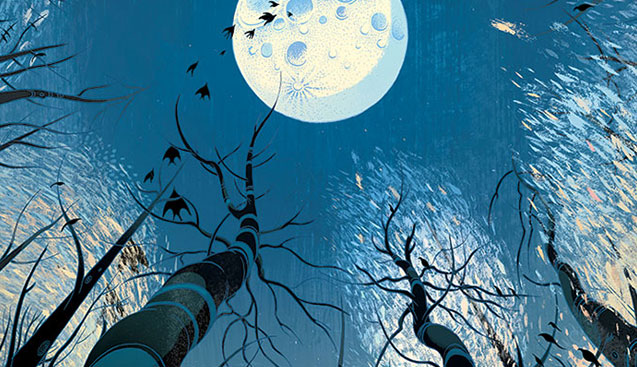Barsk: The Elephants’ Graveyard Resurrects the Smart Science Fantasy Novel
 Barsk: The Elephants’ Graveyard will take you by surprise. What starts out as a simple fantasy tale of anthropomorphic elephants morphs into a millennia-spanning sci-fi drama, complete with ancient prophecies and long-running cultural conspiracies. Lawrence M. Schoen expertly balances depth with readability, building a meaningful story that never gets stuck in its own message.
Barsk: The Elephants’ Graveyard will take you by surprise. What starts out as a simple fantasy tale of anthropomorphic elephants morphs into a millennia-spanning sci-fi drama, complete with ancient prophecies and long-running cultural conspiracies. Lawrence M. Schoen expertly balances depth with readability, building a meaningful story that never gets stuck in its own message.
Homo sapiens are a thing of the past. Now, it’s all about the elephants. And the otters. And sloths, cats, bears, dogs, cheetahs, yaks, and… you get the picture. Sentient humanoid animals rule the galaxy. The black sheep of the anthropomorphic animal kingdom, as it were, are elephants, collectively known as Fant. Their smelly, hairless bodies make the other sentients cringe, and seriously, what’s the deal with those ears? To keep the peace, a Compact was set in place that promised everyone would leave the Fant alone as long as they stayed on the soggy little planet of Barsk.
Barsk: The Elephants' Graveyard
Barsk: The Elephants' Graveyard
Hardcover $25.99
The SFnal conceits don’t stop at uplifted animals. In the Barsk universe, particles called nefshons are tied to all living creatures. Essentially, nefshons give substance to memory, allowing us to recall people we’ve known and picture them as if they were standing right in front of us. If you happen to be a Speaker, you can take a dose of koph, a drug made by the elephants, manipulate some nefshons and boom, you’re sipping hot cocoa with a lady that died 50,000 years ago. It’s not a memory—you’re actually talking to a self-aware image of that person.
The carefully constructed peace between the elephants and other species starts to crumble when one of the Fant discovers a version of koph that’s exponentially more powerful. He commits suicide to keep his discovery a secret, but rumor of it spreads, eventually reaching the Alliance. When you’re a bloated governmental agency with more power than sense, and you’ve learned of the existence of a drug that would grant you access to all knowledge of the past, there’s only one logical course of action: do everything you can to get your paws/claws on it. Including breaking the Compact and kidnapping or killing elephants as you see fit.
Barsk starts off casual, playful, and even a bit somber. The characters are just the right shade of flawed, and there’s enough mystery behind them to keep you turning pages. Midway through, threads start to come together that, by the last several chapters, transform it into a serious and philosophical tale, one that completes a story while sowing seeds for possible sequels.
If the plot summery draws scoffs—anthropomorphism and speaking with the dead? Overdone cliches every hack fantasy author whips out when it’s time for another book, right?—Schoen neatly sidesteps the tropes and drives straight towards real, engaging content. The anthropomorphism isn’t just window dressing; there are crucial story reasons for its inclusion. Nefshons lend a scientific flavor to the seance vibe, but even without mystery particles, Speaking is a crucial link between the characters, the story of the novel, and its ancient history.
Barsk: The Elephants’ Graveyard is an absolutely fascinating read: deeply imagined, smart, and strange in the best way.
The SFnal conceits don’t stop at uplifted animals. In the Barsk universe, particles called nefshons are tied to all living creatures. Essentially, nefshons give substance to memory, allowing us to recall people we’ve known and picture them as if they were standing right in front of us. If you happen to be a Speaker, you can take a dose of koph, a drug made by the elephants, manipulate some nefshons and boom, you’re sipping hot cocoa with a lady that died 50,000 years ago. It’s not a memory—you’re actually talking to a self-aware image of that person.
The carefully constructed peace between the elephants and other species starts to crumble when one of the Fant discovers a version of koph that’s exponentially more powerful. He commits suicide to keep his discovery a secret, but rumor of it spreads, eventually reaching the Alliance. When you’re a bloated governmental agency with more power than sense, and you’ve learned of the existence of a drug that would grant you access to all knowledge of the past, there’s only one logical course of action: do everything you can to get your paws/claws on it. Including breaking the Compact and kidnapping or killing elephants as you see fit.
Barsk starts off casual, playful, and even a bit somber. The characters are just the right shade of flawed, and there’s enough mystery behind them to keep you turning pages. Midway through, threads start to come together that, by the last several chapters, transform it into a serious and philosophical tale, one that completes a story while sowing seeds for possible sequels.
If the plot summery draws scoffs—anthropomorphism and speaking with the dead? Overdone cliches every hack fantasy author whips out when it’s time for another book, right?—Schoen neatly sidesteps the tropes and drives straight towards real, engaging content. The anthropomorphism isn’t just window dressing; there are crucial story reasons for its inclusion. Nefshons lend a scientific flavor to the seance vibe, but even without mystery particles, Speaking is a crucial link between the characters, the story of the novel, and its ancient history.
Barsk: The Elephants’ Graveyard is an absolutely fascinating read: deeply imagined, smart, and strange in the best way.
